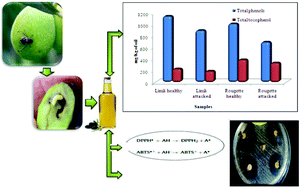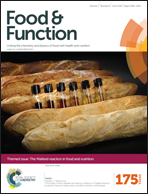The effect of the olive fruit fly (Bactrocera oleae) on quality parameters, and antioxidant and antibacterial activities of olive oil
Abstract
The present study was performed on olives from two Algerian cultivars (Limli and Rougette de Metidja) with different rates of attack by the Bactrocera oleae fly (0%, not attacked; 100%, all attacked; and real attacked %) and the corresponding olive oils. The aim was to verify the attack effect on quality parameters (free fatty acid, peroxide value, K232 and K270, oxidation stability), bioactive compounds (fatty acids and tocopherols, and total phenols and flavonoids), and on the antioxidant (reducing power, FRAP, β-carotene bleaching inhibition, ABTS and DPPH) and antibacterial (against 8 referenced human enteropathogenic bacteria by the agar disc diffusion method) capacities. Oils from infested olives were downgraded to the virgin olive oil category. Rougette de Metidja, the cultivar with a higher drupe size, was more attacked than Limli. The B. oleae attack causes an important decrease in the total phenolic contents (>30%) but to a lesser degree in the case of tocopherols. Among them, α-tocopherol is the most affected. The antioxidant and antibacterial activities were highly correlated with phenolic levels. The results of this study show the importance of controlling the fly attack because it causes a decrease in the beneficial health effects of olive oils.


 Please wait while we load your content...
Please wait while we load your content...